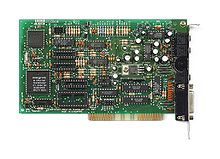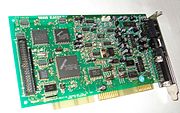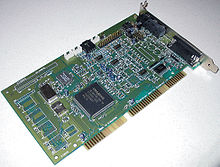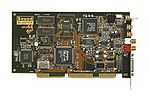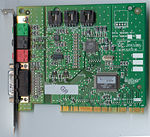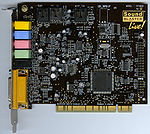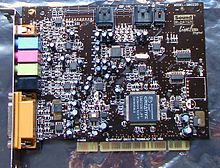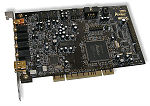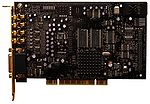- Sound Blaster
-
The Sound Blaster family of sound cards was the de facto standard for consumer audio on the IBM PC compatible system platform, until the widespread transition to Microsoft Windows 95, which standardized the programming interface at application level (eliminating the importance of backward compatibility with Sound Blaster), and the evolution in PC design led to onboard motherboard-audio, which commoditized PC audio functionality.
The creator of Sound Blaster is the Singapore-based firm Creative Technology, also known by the name of its United States subsidiary, Creative Labs.
Creative Music System and Game Blaster
Creative Music System
The history of Creative sound cards started with the release of the Creative Music System ("C/MS") board in August 1987. It contained two Philips SAA 1099 circuits, which, together, provided 12 voices of square-wave bee-in-a-box stereo sound plus some noise channels.
These circuits were featured earlier in various popular electronics magazines around the world. For many years Creative tended to use off-the-shelf components and manufacturers' reference designs for their early products. The various integrated circuits had white or black paper sheets fully covering their top thus hiding their identity. On the C/MS board in particular, the Philips chips had white pieces of paper with a fantasy CMS-301 inscription on them: real Creative parts usually had consistent CT number references.
Surprisingly, the board also contained a large 40-pin PGA (Creative Technology Programmable Logic) integrated circuit, bearing a CT 1302A CTPL 8708 serigraphed inscription and looking exactly like the DSP of the later Sound Blaster. Presumably, this DSP could be used to automate some of the sound operations, like envelope control.
Game Blaster
A year later, in 1988, Creative marketed the C/MS via Radio Shack under the name Game Blaster. This card was identical in every way to the precursor C/MS hardware. Creative did not change any of the labeling or program names on the disks that came with the Game Blaster, but also included a later revision of the game Silpheed that added C/MS support.
First generation Sound Blasters, 8-bit ISA & MCA cards
Sound Blaster 1.0, CT1320A
Sound Blaster 1.0 Date invented 1989 Invented by Creative Technology Connects to Motherboard via:
- XT or ISA Socket
Common manufacturers Creative Technology The Sound Blaster 1.0, CT1320A, was released in 1989. In addition to Game Blaster features, it had an 11-voice FM synthesizer using the Yamaha YM3812 chip, also known as OPL2. It provided perfect compatibility with the then market leader AdLib sound card, which had gained support in PC games in the preceding years. Creative used the "DSP" acronym to designate the digital audio part of the Sound Blaster. This actually stood for Digital Sound Processor, rather than the more common digital signal processor, and was really a simple micro-controller from the Intel MCS-51 family (supplied by Intel and Matra MHS, among others). It could play back monaural sampled sound at up to 23 kHz sampling frequency (approx. FM radio quality) and record at up to 12 kHz (approximately AM radio quality). The sole DSP-like feature of the circuit was ADPCM decompression.
In spite of these limitations, in less than a year, the Sound Blaster became the top-selling expansion card for the PC. It achieved this by providing a fully AdLib-compatible product, with additional features, for the same, and often a lower price. The inclusion of the game port, and its importance to its early success, is often forgotten or overlooked. PCs of this era did not include a game port. Game port cards were costly (around $50) and used one of the few expansion slots PCs had at the time. Given the choice between an AdLib card or a fully compatible Sound Blaster card that came with a game port, saved a slot, and included the "DSP" for not much more in price, many consumers opted for the Sound Blaster. In-game support for the digital portion of the card did not happen until after the Sound Blaster had gained dominance.
Sound Blaster 1.5, CT1320C
Sound Blaster 1.5
Sound Blaster 1.5 (CT1320C).Date invented 1990 Invented by Creative Technology Connects to Motherboard via:
- XT or ISA Socket
Common manufacturers Creative Technology Released in 1990, the Sound Blaster 1.5, CT1320C, dropped the C/MS chips, which were no longer popular with game developers. Instead, the board had two empty sockets, which could be user upgraded by purchasing the C/MS chips directly from Creative. Otherwise the card is similar to the Sound Blaster 1.0.[1]
Sound Blaster 2.0, CT1350
The final revision of the original Sound Blaster, the Sound Blaster 2.0, CT1350, added support for "auto-init" DMA, which assisted in producing a continuous loop of double-buffered sound output. The maximum sampling rate was increased to 44 kHz for playback, and 22 kHz for record. The Sound Blaster 2.0's PCB-layout used more highly integrated components, both shrinking the board's size and reducing manufacturing cost.
Owners of previous revision Sound Blaster boards could upgrade their board by purchasing the V2.00 DSP chip from Creative Labs, and swapping the older DSP with the newer replacement. The upgraded board gained the same capabilities as the Sound Blaster 2.0.
Sound Blaster MCV, CT5320
Sound Blaster MCV, CT5320, was a version created for IBM PS/2 model 50 and higher and their ISA-incompatible MicroChannel bus.
Second-generation Sound Blasters, 16-bit ISA & MCA cards
Sound Blaster Pro, CT1330
The Blaster Pro, CT1330, announced in May 1991, was the first significant redesign of the card's core features. The Sound Blaster Pro supported faster digital sampling rates (up to 22.05 kHz stereo or 44.1 kHz mono), added a "mixer" to provide a crude master volume control (independent of the volume of sound sources feeding the mixer), and a crude high pass or low pass filter. The Sound Blaster Pro used a pair of YM3812 chips to provide stereo music-synthesis (one for each channel). The Sound Blaster Pro was fully backward compatible with the original Sound Blaster, and by extension, the AdLib sound card. The Sound Blaster Pro was the first Creative sound card to have a built-in CD-ROM interface. Most Sound Blaster Pro cards featured a proprietary interface for a Panasonic (Matsushita MKE) drive.
Sound Blaster Pro 2, CT1600
The revised version, the Sound Blaster Pro 2, CT1600, replaced the YM3812s with a more advanced Yamaha YMF262 (OPL3). The Pro's MIDI UART was upgraded to full-duplex and offered time stamping features, but was not yet compatible with the MPU-401 interface used by professional MIDI equipment. The Sound Blaster Pro 2 was fully backward compatible with the original Sound Blaster, and by extension, the AdLib sound card. Shortly after the release of the Sound Blaster Pro 2 version, Creative discontinued the original Sound Blaster Pro.
The Sound Blaster Pro 2 was also sold with the following on-board CD-ROM controllers:
- Sound Blaster Pro 2, SCSI, CT1610
- Sound Blaster Pro 2, LMSI, CT1620
- Sound Blaster Pro 2, Sony, CT1690
- Sound Blaster Pro 2, Mitsumi, CT2600
Packaged Sound Blaster cards were initially marketed and sold into the retail-channel. Creative's domination of the PC audiocard business soon had them selling the Sound Blaster Pro 2 OEM, CT1680, to customers for integration into pre-assembled PCs.
Creative also sold Multimedia Upgrade Kits containing the Sound Blaster Pro. The kit bundled the sound card, a Matsushita CD-ROM drive (model 531 for single-speed, or 562/3 for the later double-speed (2x) drives), and several CD-ROMs of multimedia software titles. As CD-ROM technology was then new, the kit included CD-ROM software, representing a tremendous value to consumers. One such kit, named "OmniCD", included the 2x Matsushita drive along with an ISA controller card and software, including Software Toolworks Encyclopedia and Aldus PhotoStyler SE. It was compliant with the MPC Level 2 standard.
Sound Blaster Pro 2 MCV, CT5330
The Sound Blaster Pro 2 MCV, CT5330, was a version created for IBM PS/2 model 50 and higher and their MicroChannel bus.
Third generation Sound Blasters, 16-bit ISA cards
Sound Blaster 16
Main article: Sound Blaster 16The next model, the Sound Blaster 16, announced in June 1992, introduced:
- 16-bit CD-quality digital audio sampling;
- An MPU-401 compatible UART;
- A socket for the optional Advanced Signal Processor or Creative Signal Processor chip (ASP or later CSP); and
- A connector for the Wave Blaster, a wavetable daughterboard.
The Sound Blaster 16 retained the Yamaha OPL-3 for FM synthesis and a backward compatible programming interface, so most software titles written for the older Sound Blasters and Sound Blaster Pros would run without modification.
Eventually this design proved so popular that Creative made a PCI version of this card. Moving the card off the ISA bus, which was already approaching obsolescence, meant that no line for host-controlled ISA DMA was available, as the PCI slot offers no such line. Instead, the card used PCI bus mastering to transfer data from the main memory to the D/A converters. Since existing DOS programs expected to be able to initiate host-controlled ISA DMA for producing sound, backward compatibility with the older Sound Blaster cards for DOS programs required a software driver work-around; since this work-around necessarily depended on the virtual 8086 mode of the PC's CPU in order to catch and reroute accesses from the ISA DMA controller to the card itself, it failed for a number of DOS games that either were not fully compatible with this CPU mode or needed so much free conventional memory that they could not be loaded with the driver occupying part of this memory. In Microsoft Windows, there was no problem, as Creative's Windows driver software could handle both ISA and PCI cards correctly.
Sound Blaster ViBRA16
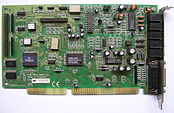 Vibra based card with FM radio: SoundForte RadioPlus SF16-FMR2 by MediaForte
Vibra based card with FM radio: SoundForte RadioPlus SF16-FMR2 by MediaForte
The Sound Blaster ViBRA16 was an inexpensive single-chip implementation of the Sound Blaster 16 for the OEM market. Creative Labs also used this chip for the Sound Blaster 32, Phone Blaster 28.8 (VIBRA + modem) and many other value-edition cards. This series included the ViBRA16 (CT2501), ViBRA16s (CT2504), ViBRA16c (CT2505) PnP and ViBRA16XV (CT2511) chips. The primary advantage of the ViBRA16 was the inclusion of a 14.4 kbit/s telephony Modem, it also functioned as a telephone.
Fourth generation Sound Blasters, 16-bit ISA cards, Dynamic Wavetable Synthesis
Sound Blaster AWE32
Main article: Sound Blaster AWE32Released in March 1994, the Sound Blaster AWE32 (Advanced Wave Effects) introduced an all new MIDI synthesizer section based on the EMU8000. The AWE32 consisted of two distinct audio sections; the Creative digital audio section (audio codec, optional CSP/ASP chip socket, Yamaha OPL3), and the E-mu MIDI synthesizer section. The synthesizer section consisted of the EMU8000 sampler and effects processor, an EMU8011 1 MB sample ROM, and 512 KB of sample RAM (expandable to 28 MB). To fit the new hardware, the AWE32 was a full-length ISA card, measuring 14 in (360 mm).
Sound Blaster 32
A derivative of the AWE32 design, the Sound Blaster 32 (SB32) was a value-oriented offering from Creative. Announced on June 6, 1995, the SB32 became the new entry-level card in the AWE32 product-line (previously held by the AWE32 Value.) The SB32 retained the AWE32's EMU8000/EMU8011 MIDI-synthesis engine and built-in instrument ROM, but dropped the onboard RAM, the Wave Blaster header, and the CSP port. The SB32 used the Vibra chip to reduce component count, which meant bass/treble/gain control was limited compared to the AWE32. The loss of onboard RAM is offset by the inclusion of 30-pin SIMM RAM sockets, which allow up to 8 MB RAM to be installed and used by the EMU engine.
Sound Blaster AWE64
Main article: Sound Blaster AWE64The AWE32's successor, the Sound Blaster AWE64 (November 1996), was significantly smaller, being a "half-length ISA card" (that term is misleading — see the pictures for size comparison). It offered similar features to the AWE32, but also had a few notable improvements, including support for greater polyphony, although this was a product of 32 extra software emulated channels. The 30-pin SIMM slots from AWE32/SB32 were replaced with a proprietary memory format which could be (expensively) purchased from Creative.
The main improvements were better compatibility with older SB models, and an improved signal-to-noise ratio. The AWE64 came in three versions: A Value version (with 512KB of RAM), a Standard version (with 1 MB of RAM), and a Gold version (with 4 MB of RAM and a separate S/PDIF output).
Fifth generation Sound Blasters, PCI cards, Multi-Channel Sound and F/X
Ensoniq AudioPCI-based cards
Main article: Ensoniq AudioPCIIn 1998, Creative acquired Ensoniq Corporation, manufacturer of the AudioPCI, a card popular with OEMs at the time. AudioPCI offered a full-featured solution, being a PCI sound card with wavetable MIDI, and offering 4-speaker DirectSound3D surround sound, A3D emulation, and full DOS legacy support. Creative's acquisition filled a market segment where Live! was too expensive, and it gave them excellent DOS support, a feature that was proving difficult for companies to get working with PCI cards (as described above in the Sound Blaster 16 section, early PCI audio cards had to work around the missing ISA-DMA lines of the PCI slot to run with existing DOS software, and often the work-arounds did not function well, or worked only in DOS boxes within Microsoft Windows).
Creative released many cards using the original AudioPCI chip, Ensoniq ES1370, and several boards using revised versions of this chip (ES1371 and ES1373), and some with relabeled AudioPCI chips (they say Creative on them.) Boards using AudioPCI tech are usually easily identifiable by the board design and the chip size because they all look quite similar. Such boards include Sound Blaster PCI64 (April 1998), PCI128 (July 1998), Creative Ensoniq AudioPCI, Vibra PCI and Sound Blaster 16 PCI.
These cards were full-featured, but the features were limited in capability. MIDI, for example, was rather poor in quality and there was no ability to customize the sample sets beyond the three pre-made sets (2, 4, and 8 MB) included with the cards. The chips do not support hardware acceleration of any kind as they are entirely software-driven. These cards also did not support SoundFonts.
Sound Blaster Live! (Original)
Main article: Sound Blaster Live!When the Sound Blaster Live! was introduced in August 1998, the use of a programmable digital signal processor in consumer PC-audio was unprecedented. The Live was built around Creative's own programmable audio DSP, the EMU10K1, and represented a paradigm shift in PC audio. With a transistor count of 2.44 million, EMU10K1 was capable of 1,000 MIPS. The EMU10K1's advertised capabilities had previously been limited to professional audiocards (such as those made by Turtle Beach).
The EMU10K1 (and its successors) did not use on-card RAM/ROM storage for instrument samples, instead it used a high-speed PCI DMA interface to access sample-data stored in the host-PC's system memory. The EMU needed only a single extra chip to interface with the PCI bus. Not only did this arrangement eliminate the need for on-card storage, it also raised instrument-sample and sound-effect size from the AWE64's 8 MB, to the size of host system memory. The EMU10K1 and FX8010 chips offloaded functions previously handled by separate custom chips.
All members of the SB Live! family were built on the EMU10K1, came standard with four-channel analog audio outputs, and the ubiquitous 15-pin MIDI/Joystick multiport, and similar AC'97 architecture (isolation of ADC/DAC functionality into a separate codec chip.) For game titles, EAX 1.0 (and later 2.0) (environmental audio extensions, which briefly competed with the now defunct A3D) was hardware-accelerated, adding acoustic audio-effects at the cost of some host-CPU cycles. The EMU10K1 provided high-quality 64-voice sample-based synthesizer (a.k.a. wavetable), with self-produced or third-party customized patches or "Soundfonts", and the ability to resample the audio output as input and apply a range of real-time DSP effects to any set of audio subchannels present in the device.
The first model and flagship of the SB/Live family was the SB Live! Gold. Featuring gold tracings on all major analog traces and external sockets, an EMI-suppressing printed circuit board substrate and lacquer, the Gold came standard with a daughterboard that implemented a separate 4-channel alternative mini-DIN digital output to Creative-branded internal-DAC speaker sets, a S/P-DIF digital audio Input and Output with separate software mappings, and a fully decoded MIDI interface with separate Input and Output (along with on mini-DIN converter.) The Gold highlighted many features aimed at music composition; ease-of-use (plug-and-play for musicians), realtime loopback-recording of the MIDI-synthesizer (with full freedom of Soundfonts, and environmental effects such as reverb, etc.), and bundled MIDI-software.
The mainstream model was the Sound Blaster Live! Like the Gold, the Live featured multi-speaker analog output (up to four channels), and identical music/sound generation capabilities (without the bundled MIDI software and interfacing-equipment.)
Sound Blaster PCI512
The Sound Blaster PCI512 is an EMU10K1-based sound card designed to fill a lower cost segment than the Live! Value. It is capable of most of the Live! Value's features aside from being limited to 512 MIDI voice polyphony (a software-based limitation), lacking digital I/O, removal of expansion headers, and only stereo or quadraphonic output support. The card's circuit layout is somewhat simpler than that of the Live! series.[2][3]
Sound Blaster Live! (later 5.1-channel revision)
Later versions of the Live!, usually called Live! 5.1, offered 5.1-channel support which adds a center channel speaker and LFE subwoofer output, most useful for movie watching. The Live! 5.1 could also use one of the 3.5 mm jack ports as an SPDIF out, which allowed the connection of an external decoder.
Sound Blaster Audigy series
Main article: Sound Blaster AudigyThe Sound Blaster Audigy (August 2001) featured the Audigy processor (EMU10K2), an improved version of the EMU10K1 processor that shipped with the Sound Blaster Live!. The Audigy could process up to four EAX environments simultaneously with its upgraded on-chip DSP and native EAX 3.0 ADVANCED HD support, and supported up to 5.1-channel output.
The Audigy was controversially advertised as a 24-bit sound card. The EMU10K2's audio transport (DMA engine) was fixed at 16-bit sample precision at 48 kHz (like the EMU10K1 in the original Live!), and all audio had to be resampled to 48 kHz in order to be accepted by the DSP (for recording or rendering to output.)
Sound Blaster Audigy 2 (September 2002) featured an updated EMU10K2 processor, sometimes referred to as EMU10K2.5, with an improved DMA engine capable of 24-bit precision. Up to 192 kHz was supported for stereo playback/record, while 6.1 was capped at 96 kHz. In addition, Audigy 2 supported up to 6.1 (later 7.1) speakers and had improved signal-to-noise ratio (SNR) over the Audigy (106 vs. 100 decibels (A)). It also featured built-in Dolby Digital EX 6.1 and 7.1 decoding for improved DVD play-back.
Sound Blaster Audigy 2 ZS (2003) is essentially an Audigy 2 with updated DAC and opamps. Audigy 2 ZS uses the Cirrus Logic CS4382 DAC together with the opamps and can produce an output SNR of 108 dB. There were a few slight printed circuit board modifications and 7.1 audio support was added.
Sound Blaster Audigy 4 Pro was an Audigy 2 ZS with updated DACs and ADCs, the new DAC being the Cirrus Logic CS4398, boosting the output SNR to 113 dB. Other than a breakout box, it has no distinguishable difference from the Audigy 2 ZS. The DSP is identical to the Audigy 2 ZS's but Creative put an "Audigy 4" sticker to cover the chip, making it appear as if it is a new chip. The Audigy 4 Pro is not to be confused with the Audigy 4 (Value) which contains lower quality DACs and does not have golden plated jacks. The Audigy 4 (Value) is more in line with the Audigy 2 Value series. The Audigy 4 had a shorter life span than its predecessors, due to the short window between it and the next-generation Sound Blaster X-Fi.
Sound Blaster X-Fi
Main article: Sound Blaster X-FiThe X-Fi (for "Extreme Fidelity") was released in August 2005 and currently comes in XtremeGamer, Titanium, Titanium Fatal1ty Professional, Titanium Fatal1ty Champion and Elite Pro configurations. The 130 nm EMU20K1 (or EMU20K2 for Titanium series models) audio chip operates at 400 MHz and has 51 million transistors. The computational power of this processor, i.e. its performance, is estimated as 10,000 MIPS, which is about 24 times higher than the estimated performance of its predecessor, the Audigy processor. Beginning with the 2008 Titanium models, newer X-Fi cards switched from PCI to PCI Express x1 connectors. With the X-Fi's "Active Modal Architecture" (AMA), the user can choose one of three optimization modes: Gaming, Entertainment, and Creation; each enabling a combination of the features of the chipset. The X-Fi uses EAX 5.0 which supports up to 128 3D-positioned voices with up to four effects applied to each. This release also included the 24-bit crystallizer, which is intended to pronounce percussion elements by placing some emphasis on low and high pitched parts of the sound. The X-Fi, at its release, offered some of the most powerful mixing capabilities available, making it a powerful entry-level card for home musicians. The other big improvement in the X-Fi over the previous Audigy designs was the complete overhaul of the resampling engine on the card. The previous Audigy cards had their DSPs locked at 48/16, meaning any content that didn't match was resampled on the card in hardware; which was done poorly and resulted in a lot of intermodulation distortion. Many hardcore users worked around this by means of resampling their content using high quality software decoders, usually in the form of a plugin in their media player. Creative completely re-wrote the resampling method used on the X-Fi and dedicated more than half of the power of the DSP to the process; resulting in a very clean resample.[citation needed]
Sound Blaster Recon3D
Main article: Sound Blaster Recon3DThe Recon3D series were released in August 2011 and include PCI Express x1 cards such as Recon3D PCIe, Recon3D Fatal1ty Professional and Recon3D Fatal1ty Champion. The cards use the new integrated Sound Core3D chip, which features the Quartet DSP from the X-Fi series as well as integrated DAC, ADC and I/O interface in a 56-pin package. [4]
Connectors
Sound Blaster cards since 1999 conform to Microsoft's PC 99 standard for color coding the external connectors as follows:
Color Function Pink Analog microphone input. Light blue Analog line level input. Lime green Analog line level output for the main stereo signal (front speakers or headphones). Black Analog line level output for rear speakers. Silver Analog line level output for side speakers. Orange S/PDIF digital output (sometimes used as an analog line output for a center and/or subwoofer speaker instead) Up until the AWE line, Creative cards has short text inscriptions on the backplane of the card, indicating which port does what (i.e. Mic, Spk, Aux In, Aux Out). On later cards, the text inscriptions were changed to icons. With the latest cards from Creative, the cards were changed to use numbers as the ports are flexi-jacks and can have different functions assigned to them at run-time (i.e. changed from speaker output to mic in), but a color overlay sticker is included with retail units to help consumers identify the commonly used functions of the ports in their default modes.
Driver software modification (soft mod)
Some drivers from the Audigy 2 ZS have been soft-modded by enthusiasts. These can be installed on Creative's older cards, including Sound Blaster Live!, Audigy, and Audigy 2. It has been claimed to offer improved sound quality, hardware acceleration of higher EAX versions in games, 64-channel mixing for Audigy 1, and an overall improvement in the card's performance. Several forum posts across the web have reported favorable results with this technique, excepting Live! users where the drivers only add the ability to use the newer software applications (i.e. the newer mixer applet). Comments on forums from developers of the software mod have said that Live!'s hardware is not capable of EAX3 nor 64-channels of hardware sound mixing.
Later, in 2004, Creative released updated drivers top-to-bottom for the Audigy through Audigy 4 line that put these cards basically at feature parity on a software level. As of 2006, the entire Audigy lineup uses the same driver package. DSP decoding at the driver level on other cards than Audigy 2 ZS and 4 is still not supported by official drivers, but it works with soft-modded drivers on the other cards with hardware DSP (like Audigy 2 6.1).
When Windows Vista was released, there was only a single beta driver for the Creative Audigy series that was usable on the operating system with minimal functionality and frequent instability reported by users. A Creative Forum activist named Daniel K. (His real name is Daniel Kawakami who is from Brazil) modified drivers from the X-Fi and applied it to the Audigy and Live! series, restoring most if not all of the features that came with the original XP setup CD in Vista. X-Fi drivers have noticeably better sound quality under Vista, and more bug fixes because of the newer build (last modified version is 2.15.0004EQ April). He managed to enable the X-Fi Crystallizer to work on Audigy series cards in software, however because of the patents involved, he was forced to remove all the modified drivers and DLL patch. The event ended as a PR disaster for Creative as they put legal pressure on a user who had succeeded in creating working Vista drivers where Creative had failed, especially on the Creative Forum and technical blog sites. It is possible that many previously loyal customers refused to buy Creative products and turned to other brands as a result.
Daniel K has since stopped developing modified support files for the above sound cards, however some of the files (as of July, 2008) may still be hosted on individual tech/blog sites. Creative has since then released a newer official Audigy Vista driver (2.18.0000 as of July 28, 2008) due to public and consumer pressure.
Audio DSP circuits
Name Bit depth EAX Transistors Notes EMU10K1 16-bit 2.0 2.44 million 350 nm, 335 MIPS, 32 DirectSound3D sound channels EMU10K2 16-bit 3.0 4 million 200 MHz, 64 DirectSound3D sound channels EMU10K2.5 24-bit 4.0 4,6 million 180 nm, 200 MHz, 424+ MIPS, 64 DirectSound3D sound channels EMU20K1 24-bit 5.0 51 million 130 nm, 400 MHz, 10,340 MIPS, 128 DirectSound3D sound channels EMU20K2 24-bit 5.0 ? Fixes bugs in EMU20K1, PCI Express Sound Core3D 24-bit ? ? Integrated analog codec and digital I/O See also
- AdLib
- Auzentech
- C-Media
- Ensoniq
- Gravis Ultrasound
- M-Audio
- Media Vision
- Realtek
- Roland Corporation
- TerraTec
- Turtle Beach Systems
- VIA Envy
- VDMSound
- Yamaha sound chips
References
- ^ Sound Blaster Optional Hardware & Software Catalog, Creative Labs Inc. (Page 2)
- ^ Creative Labs Sound Blaster PCI 512 manual
- ^ Creative Sound Blaster PCI512 review, PC Pro, March 2002, Issue 82.
- ^ http://asia.creative.com/corporate/pressroom/releases/?pid=13247
- "Creative Announces Sound Blaster 32" by Creative Technology on Usenet, June 23, 1995, retrieved January 5, 2006
External links
- Programming the AdLib/Sound Blaster FM Music Chips
- Sound Blaster FM emulator and online player for AdLib/Sound Blaster FM music
- Setting the BLASTER environment variable
- Creative Labs - History and Milestones
- kX Project (independent WDM driver for EMU10K1 and EMU10K2-based soundcards)
- X-Fi Preview/Review: Creative X-Fi Fatality FPS is a funky piece of kit
- Creative SoundBlaster X-Fi 24-bit Crystalizer
- Technical information on the Creative Mini Din connector
- ALive! - The Sound Blaster Live! Resource
- Creative Labs Driver Download
- List of Sound Blaster Products
- Sound Blaster Legacy PCI Product Information and Troubshooting (including various model numbers used for each product)
Creative Technology Sound Blaster sound cards Categories:- IBM PC compatibles
- Creative Technology products
- Sound cards
- 1987 introductions
- Singaporean brands
Wikimedia Foundation. 2010.


